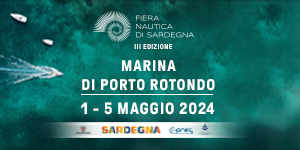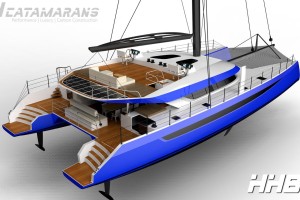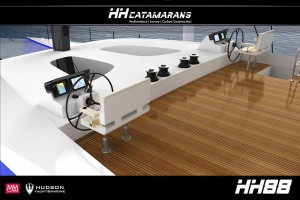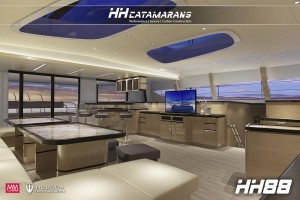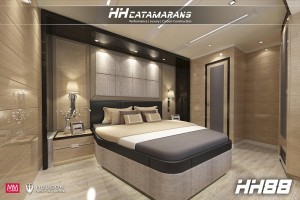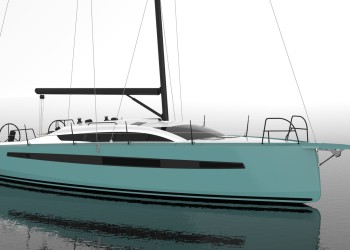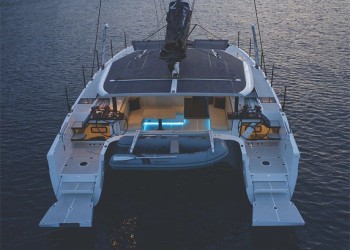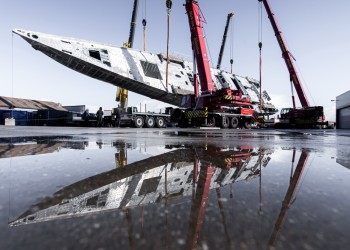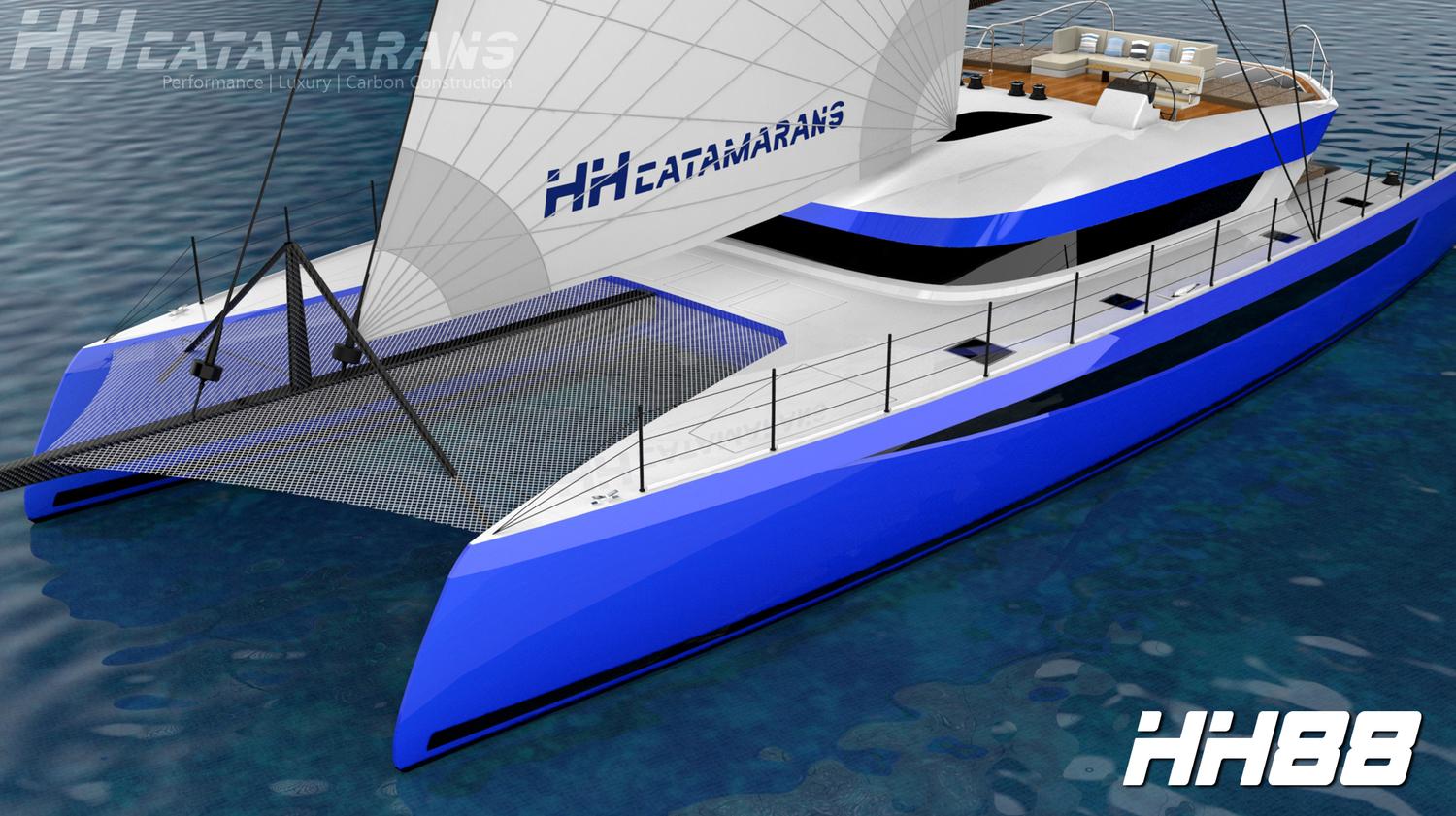
Hudson Yacht Group is now ready for its most ambitious project to date: the new HH 88
The Hudson Yacht Groupʼs new flagship, the HH88, is now in build
Having achieved so much with their stunning and fast mid-size multihulls a step up was surely always on the cards... and you will not be disappointed
With clever design, precision engineering and meticulous hightech carbon construction, Hudson Yacht Group has been developing and refining luxury performance catamarans along with design partners at Morrelli & Melvin for almost a decade. Their hard work and innovations have led to a true amalgam of luxury and performance, which used to be difficult to achieve in the same yacht yet are now proven throughout their product line of semicustom HH 50, 55 and 66ft models.
Each has delivered for their owners precisely what was asked: a safe, stylish, comfortable and seaworthy platform for everything from highspeed day racing to long-distance fast passagemaking and family cruising. HH cats are unique in delivering this experience due to incredible attention to detail in everything from the advanced composite technologies used in hull and deck shells and related structures, to the focus on maximising utility and strength, yet keeping light weight in all the interior elements so that weight targets can be reached to achieve the expected design performance.
Having proven this now in three product lines, Hudson Yacht Group is now ready for its most ambitious project to date: the new HH 88, a yacht whose concept aligns with HH’s other luxury cats but at a size and scale to give the look and feel of a true superyacht. The design development of the HH 88 was more than simply scaling a smaller design into a larger package, this is a whole new paradigm. It took a concerted effort to meet the goals of comfort and utility while staying within what the physics allowed in engineering, cost and performance.
‘We have to work to strict weight tolerances to reach the intended goals in sailing performance,’ says boatbuilder Paul Hakes. His decades of experience building high-tech monohull raceboats in carbon composites gave him an appreciation for the equal if not even greater importance of minding every kilo when building large cats.
‘Working with the owner and his wishes for accommodation standards and features on this boat required close cooperation with the Morrelli & Melvin team and our own engineers,’ he says. ‘It took us three months to do the weight studies needed to develop weight and trim targets, so being slack on this would have a major effect on performance. Even though this boat has no specific racing plans, performance under sail is still important.’
Superyacht luxuries
The size of the HH 88 allows for some extraordinary features simply not allowable on smaller-sized cats of this genre. These include accommodations for the luxury charter market so that 10 guests and four crew may be comfortable: four guest suites and an additional double cabin, a spacious aft cockpit with fresh water jacuzzi surrounded by loungers and an alfresco dining area; air conditioning in the main cabin and flybridge spaces; and a master stateroom on the main deck forward of the saloon.
Styling is also luxurious, highlighted by illuminated granite with carbon details and lightweight foam-cored furniture with high gloss mahogany veneer and decorative cored veneers in drawer and cupboard fronts.
The infrastructure to support this luxury has been carefully considered and planned for both functionality and space, but also to hit the allimportant weight and trim targets. The galley is below the main deck in one hull and will be fitted with a sixburner range, top-end equipment and generous counter space. Air conditioning will be capable of running overnight in “silent mode” powered by an impressive 70kW lithium-ion battery bank, a huge weight saving over standard battery types. These batteries will be quickly recharged daily with an impressive 6kW solar arrangement to reduce the carried fuel needed to power two 24kW synchronised generators.
Full self-sufficiency while under charter is achieved by having the equipment needed to both entertain and transport the guests, as well as to re-supply when needed. Accordingly, the HH 88 has space for a jet ski, a 5.75m tender and dive gear to be stowed aft, with a large forepeak and foredeck lockers for sail and fender storage.
Advanced carbon composites
Paul Hakes has spent a lifetime working through all the details of how to get the best possible laminates in carbon. Starting with the tooling, he focuses on rigidity and stability to preserve the intended shapes in the two-part hull tools, yet has built in the ability to be adaptable for different sized hulls.
In this way, if a new client wanted a 77-footer rather than an HH 88, Hakes and team can to adapt the tooling rather than build an entirely new toolset. This saves not only on cost, but also time in a boatbuilding process that would otherwise be measured in years and not months.
Hakes uses ‘female-direct’ tools, where the moulds are built in plywood and glassfibre, sprayed with a 15mm-thick tooling putty that is then milled using a 20m x 5m x 7m five-axis CNC milling machine before a final layer of gelcoat is applied. ‘The middle portions of the moulds are adaptable in length, so with this system we can not only have multiple releases of new hulls, but also remain flexible should there be a change in specifications,’ he says.
For the hull, deck and structural parts special triaxial carbon weaves are sourced from a local supplier and infused under vacuum pressure with epoxy resin to get the perfect balance of penetration and adhesion in all the laminates. There are no voids or dry spots, nor over-saturation producing excess resin weight. This same attention to creating perfect laminations is given to all boats built by Hudson Yacht Group.
For the HH 88 with its multiple deck layers and two hulls set under a generous sailplan, engineering the composites to meet both the static rig loads and also the off-axis racking loads was quite a challenge. The mandate to save weight wherever possible is strong for all performance catamarans, but doing so and not accounting for these complex racking loads would jeopardise the structural stability and integrity of this large yacht, even though it is not designed to fly a hull like some of its smaller brethren. In fact the HH 88 is designed to have no more than four degrees of heel to maintain the expected comfort levels but can still cruise at impressive speeds.
This is achieved by the design and fabrication of five massive main bulkheads that tie together hulls and decks in one massive composite structure to accommodate the enormous racking loads that can arise in a multihull of this size. Rather than relying on compression posts to handle these loads, this style of structure is more reliable and, in the end, more efficient for its weight to tie together the complex loads. All of the modular parts are fabricated separately then brought together in a huge assembly jig where alignment is assured along with efficient bonding and continued adherence to those ever-important weight targets.
Cost and performance of foils
The high performance-oriented boats in the HH product line rely on the very latest in curved foil design to produce the lifting force needed to reduce displacement and increase stability to balance the forces produced in these boats’ powerful sails. For the HH 88, however, due to its massive size there were other considerations in choosing the right appendages.
First, there would need to be a significant reduction in weight and windage of the hulls and superstructure to get the same proportionate performance and there was no interest in further compromise due to all of the luxury feature requirements in the design concept.
Second, simply adding more sail area and a taller spar would not help much unless a significant increase was committed to the modulus carbon in the spar, and that too was deemed beyond the cost efficiency of the project.
Third, trying to design, fabricate and install similar curved retractable foils would also add significantly to the cost without much benefit in performance gain in a catamaran designed to not fly a hull at all. So, a short keel design for each hull was chosen that would not only reduce leeway at minimal drag, but also save a ton of weight and about half a million dollars in cost.
‘We did some VPP studies on the various options,’ says Hakes, ‘and were surprised to learn that the loss in performance was not only minimal – like 10 per cent - but this was primarily in only upwind sailing angles. An achievable speed of 20kts is not the same as 22kts, but neither is the massive additional cost and complexity. In all we are happy with the results that are nicely within this already ambitious design concept.’
For more information on HH Catamarans: http://www.hhcatamarans.com





